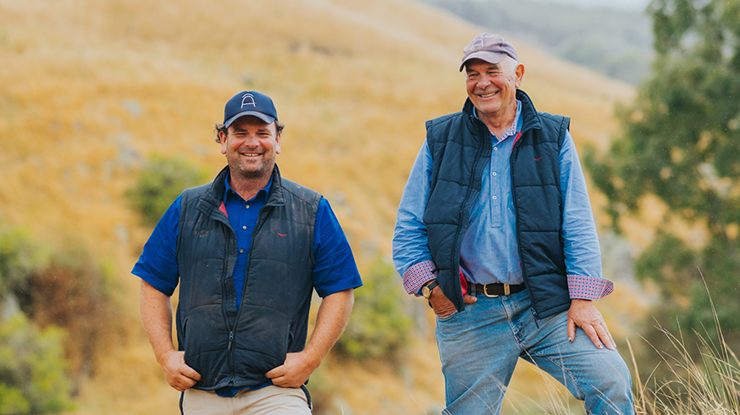 Nick and David Allen on their farm 'Boorook', Mortlake, Victoria.
Nick and David Allen on their farm 'Boorook', Mortlake, Victoria.
The Allens' south-western Victorian grazing business is proof reducing on-farm emissions doesn't have to come at a price.
"There's nothing to lose by reducing your carbon footprint and improving productivity," David Allen said.
"It's a real win-win for producers to increase efficiency.
"You're not only increasing productivity and profitability, but you're also supporting the environment by reducing emissions."
The family takes a long-term view to ensure a successful and sustainable business for future generations. "We're ensuring the next generation are leading the way," David said.
"My son Nick has complete control of the farm and is production-focused, whereas I focus on sustainability, carbon and emissions – it's a very holistic view of the entire operation."
Two-pronged approach
The Allens focus on two key management areas to ensure their carbon reduction goals feed into their broader business management plans.
These are:
- Carbon sequestration through on-farm efficiencies such as maintaining ground cover, rotational grazing, tree planting and a soil carbon project registered with the Clean Energy Regulator.
- Emissions reductions through renewable electricity and improved feed efficiencies through genetic selection. This leads to improved turn-off rates, which reduces total methane production.
On-farm strategies
The Allens use estimated breeding values (EBVs) and advice from their bull breeder to select cattle which are quick growing, efficient and fertile.
"With improved nutrition, feed efficiency and genetics, we're turning cattle off earlier," David said.
"Our conception rates are now 94.5% for cows and 92% for heifers."
They've also shortened the time cattle are on-farm – pulling the previous turn-off age of 24–30 months back to 14–20 months.
"This has a big impact on emissions as we're achieving quicker returns, a lower emissions output, and a stronger long-term financial baseline."
The Allens manage a rotational grazing system, with high-density stocking rates that see cattle regularly moved between paddocks – sometimes daily – providing rest periods for pastures of 30–60 days.
"We aim to have 100% ground cover, 100% of the time. Our 150 paddocks are grazed 25.8% of the time and rested for 74.2%.
"All this is lowering our carbon footprint in one way or another.
"Everything is interconnected. If you have healthy soil, you have healthy pasture. If you have healthy pasture, you have healthy waterways. If you have healthy pasture and water, you have healthy stock. Nothing works in isolation."
Starting the journey
Baselining their carbon footprint was the first step to reduce carbon emissions.
"Simply identifying opportunities to improve efficiencies will help deliver a smaller carbon footprint and savings," David said.
"The carbon framework allows us to market our product as a carbon neutral or low carbon status. It's opened up opportunities for new revenue streams and sustainable management practices."
These can include supplying grassfed cattle to carbon neutral or low carbon supermarket brands.
Tools of the trade
"We've used various tools over the years – such as the Sheep and Beef Greenhouse Accounting Framework (SB-GAF) and, more recently, the new Australian Feedbase Monitor to understand and use refined data that's relative to our production."
David is keen to use the new MLA Carbon Calculator to measure and monitor changes in their business' emissions.
"As an industry, and personally as a producer, we're in the fortunate position to be able to mitigate emissions and influence climate change by sequestering carbon into the soil or vegetation."






